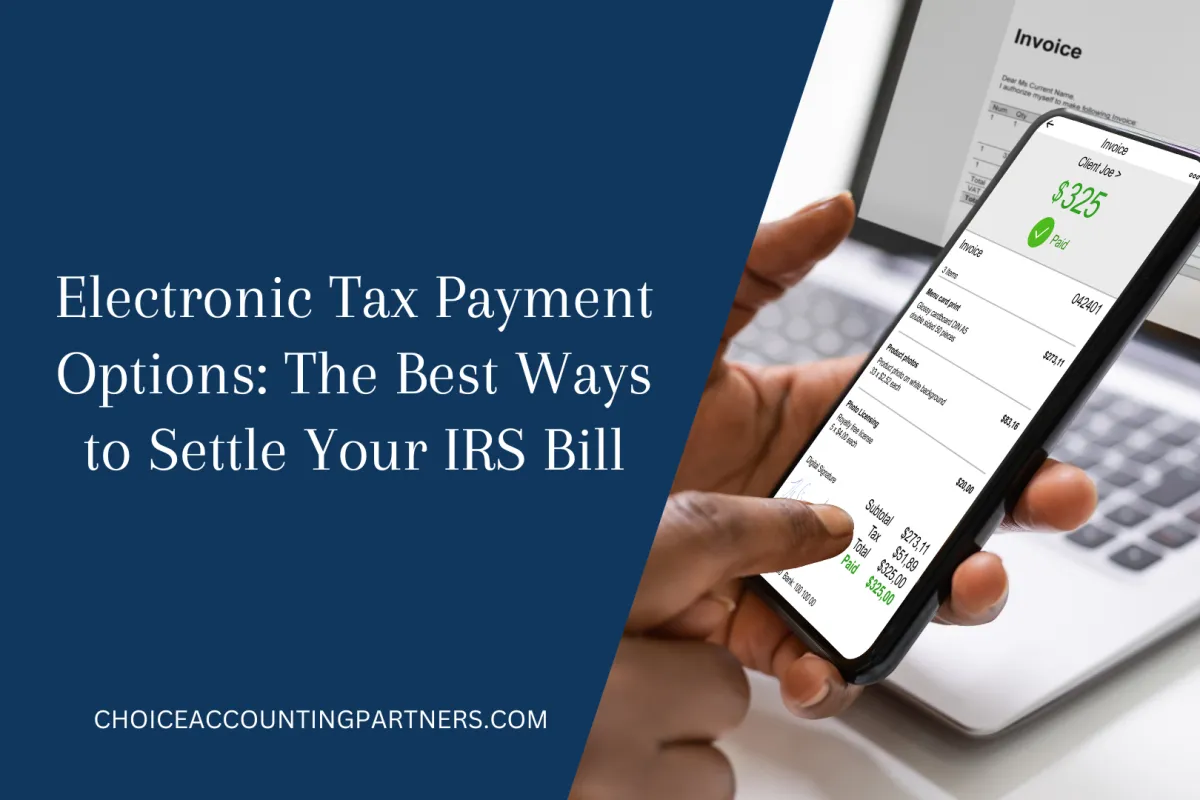

ON THE BLOG

Electronic Tax Payment Options: The Best Ways to Settle Your IRS Bill
Electronic Tax Payment Options: The Best Ways to Settle Your IRS Bill
Introduction:
The IRS reports that most taxpayers receive refunds—lucky them! But for those of us who owe taxes after filing, finding the best payment method is important.
The good news? Paying electronically is fast, secure, and offers several options to fit your needs. Here’s a breakdown of six easy ways to make your tax payment this filing season.

1. Credit Card, Debit Card, or Digital Wallet
One of the most popular ways to pay is by using a credit or debit card. The IRS also accepts payments through digital wallets like PayPal and Click to Pay. These transactions are processed through IRS-approved payment providers, and while there is a small processing fee, using a rewards credit card could help offset some of the cost.
For 2025, the IRS has authorized two payment processors:
Link2Gov Corporation (pay1040.com) | 888-PAY-1040
Fees: 1.75% of the amount paid or a $2.15 minimum
ACI Payments, Inc. (fed.acipayonline.com) | 888-UPAY-TAX
Fees: 1.85% of the amount paid or a $2.10 minimum
More details on fees and accepted payment methods are available on the IRS website.
2. Check If Your Parents Can Still Claim You2. Electronic Funds Withdrawal (EFW)
If you're e-filing your return, you can authorize an automatic withdrawal directly from your bank account. There’s no IRS fee for this method, but check with your bank for any potential charges. Keep in mind, EFW is only available when filing electronically through tax software or a tax professional.
For more information, visit the IRS Electronic Funds Withdrawal page.
3. Direct Pay
For those who prefer to initiate the payment themselves, IRS Direct Pay allows you to securely transfer funds from your checking or savings account. It’s free, doesn’t require pre-registration, and lets you schedule payments up to a year in advance.
You'll receive immediate confirmation after submitting your payment, but it's a good idea to set a reminder for scheduled payments to ensure sufficient funds are in your account.
4. IRS Online Account Payments
The IRS encourages taxpayers to create an IRS Online Account, which allows you to:
Make tax payments
View payment history
Check scheduled payments
Set up a payment plan if needed
This is a great option for managing your tax obligations all in one place.
5. Electronic Federal Tax Payment System (EFTPS)
EFTPS is a long-standing payment system used by individuals and businesses to pay taxes electronically. While it requires an initial setup with an account and PIN, it allows for scheduled payments and provides email reminders before transactions occur.
6. Cash Payments
If you prefer to pay in cash, the IRS offers two options:
IRS Taxpayer Assistance Centers (TACs) – Some IRS offices accept cash payments, but you must schedule an appointment at least 30 days in advance. Call (844) 545-5640 to find a location near you. Learn more at IRS In-Person Payments.
Retail Partners – You can also pay in cash at participating retailers like CVS, Walgreens, Walmart, and 7-Eleven through the IRS’s VanillaDirect program. This option requires online verification before receiving a payment code to use in-store. There’s a $500 limit per transaction and a $1.50 fee per payment.
Choosing the Right Payment Method
Each of these options has its own benefits, so consider what works best for your financial situation. Whether you prefer the ease of a credit card, the security of direct transfers, or the flexibility of a payment plan, paying your taxes electronically has never been more convenient.
And remember, the tax payment deadline is April 15, 2025—so plan ahead to avoid penalties or interest!
💻 Need expert guidance on tax planning and payments? Book an online consultation today
Stay tuned for more tax tips and strategies to keep you prepared year-round!
Office: 3480 Preston Ridge Ste 500,
Alpharetta, GA 30005
Call: (470) 977-3564
Email: info@choiceaccountingpartners.com
Office: 3480 Preston Ridge Ste 500,
Alpharetta, GA 30005
Call: 470-977-3564
Email: info@choiceaccountingpartners.com





